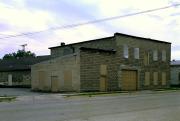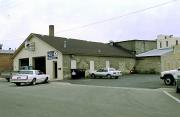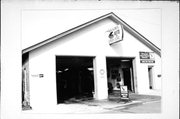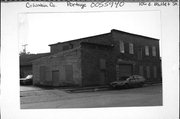| Additional Information: | Overhanging cornice; windows boarded; overhead entrance added; rear, one story gable with segmental arch lintels roof section in (48/23) and a one story, lean-to roof side addition.
M.R. Keegan as Keegand, Smith and Irwin founded a small scale foundry which operated between 1862 and 1865. He transported a warehouse from the bank of the Wisconsin River to the canal and converted it to his shop. Keegan sold this business to James Fyfe in 1865. James Fyfe and Company relocated the business in a building on the site of the Cuff feed mill at Dodge and E. Wisconsin. He rane a general jobbing and repair shop, a small establishment assembling parts both purchazsed and produced in house in a manner typical of the times. In 1867, he added hop presses to his inventory of produced goods. In 1868-1869, he advertised his foundry and machine shop (Farnham and Vivian 1868-1869: Portage Foundry and Machine Shop,... Manufactureres of Hop Stoves and Presses. Orders taken for the manufacture and repair of all Kinds of Machinery. Threshing Machines and Plow Castings, & c, constantly on hand.
When hop production failed, Fyfe sold the firm in 1872 to the Portage Manufacturing company (Platt 1872). In 1873, the business was reorganized as the Portage Iron Works with James Fyfe as manager. Fyfe became sole proprietor once again in 1878. The iron works began to manufacture chilled plows in 1878. About 1879, Fyfe sold a partial interest to partner John Anderson and the company became James Fyfe & Co. Shortly thereafter, a fire dest5royed the operation. The partners may have sold the company to R.B. Wentworth, but Wentworth retained the names James Fyfe and Company (R.L. Polk & Co. & Co. 1884-85). When Wentworth resold the company remains unclear. In the 1880s, Fyfe appears to operate the foundry and perhaps Wentworth's planing mill. James Fyfe and Company grew from a company employing two hands to produce castings and complete repairs in 1870 to a firm employing an average of 8 hands which produced 800 chilled iron plows in 1880 (U.S. Bureau of the Census 1870; 1880 [industrial schedules).
By 1893, this company emerged again as the Portage Iron Wroks, and Fyfe was no longer involved with the company. Between 1893 and 1904, James Baird & Co. advertised as proprietors of the Portage Iron Works which manufactured brass and iron castings and completed engine and machinery repair (Polk, R.L. & Co. 1893-94; 1903-04). In addition to agricultural equipment, the Portage Iron Works produced architecturla cast iron ornament. Later examples dating to 1900 appear on commercial buildings at 201 (25/0) and 211 (25/3) DeWitt. By about 1905, James Baird sold a partial interest in the Portage Iron Works which be came Baird and Slinger (Polk, R.L. & Co. 1905-06; 1909-10). The company itself remained at the corner of E. Wisconsin and Dodge (Moore, S. 1908). By 1913, Baird and Slinger operated primarily as machinists entering the automobile repair business and gradually dropping the iron foundry portion of their concern. Between 1920 and 1921, Baird left the Portage Iron Works, and it became kno2wn as Slinger Foundry, Machine, and Auto Co. with Slinger and sond as proprietors (Polk, R.L. Co. 1919-1920; 1921). Slinger foundry and Machine Shops employed ten individual who produced castings in 1925 (Wisconsin Power and Light ca. 1925: 6; Butterfield 1880: 633, 663, 898; Portage Daily Register 9/3/1909; Wisconsin Sttae Register 1862 [11/1: 3/1]). In 1920, the Singer Foundry, Machine and Auto Company had entered the more profitable automobile retail business and constructed what later became known as the Hyland Garage in 1920 at 201-211 E. Wisconsin (48/25) In 1935, the Hyland Garage relocated at this building and became Portage's Chevrolet dealer (Portage Daily Register 1/2/1935; 1952 [7/2: 2/9-11]).
The extant foundry buildings are located immediately to the northeast of the Hyland Garage building. The auto display room and garage appears to represent an addition to rather than a replacement of the original factory buildings. The oldest remaining portion of the foundry probably erected about 1891 is the east, one story, brick portion of 106 E. Mullett (48/23)e. The west end of the building was erected between 1905 and 1910. By ca. 1928 through 1937, the Nold Wholesale Company leased these quarters. The building at 120 E. Mullett (48/22) was erected by Slinger about 1918 and occupied by the Frank Fruit Company between about 1929 and 1948. Although the original buildings associated with the foundry prior to 1890 no longer remain, those used after 1890 except for a portion just southwest of 120 E. Mullett are extant. Thus, Slinger Foundry, Machine, and Auto Company expaneded north away from the site of its first building, the east portion of 106 E. Mullett (Sanborn Perris Map Co. 1918; 1929; Portage Daily Register 7/2/1952: 27). |
|---|




